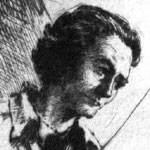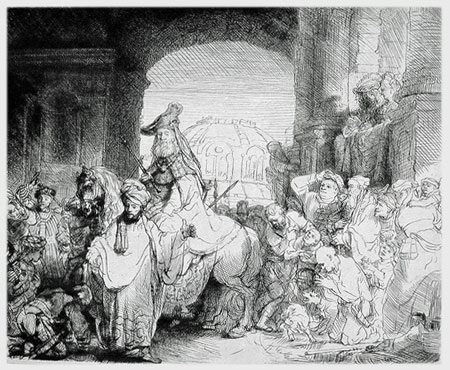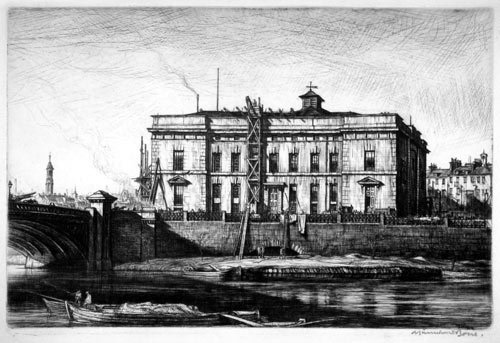Drypoint
 In
etching if the artist draws vigorously
into the ground he may unintentionally
score into the copper beneath. The origins
of drypoint probably lie in such an accident.
Though closely allied to and often used
in conjunction with etching, pure drypoint,
as its name implies, involves no use of
wet acid. The artist works directly into
the copper surface with a drypoint needle
or a burin. In scoring the copper the needle
raises a shaving of metal on either side
of the furrow, which holds the ink and
prints as a rich velvety smudge known as
the “burr”. In engraving this
is polished away to give a sharp clean-cut
line but the residual burr is the chief
characteristic and beauty of drypoint. In
etching if the artist draws vigorously
into the ground he may unintentionally
score into the copper beneath. The origins
of drypoint probably lie in such an accident.
Though closely allied to and often used
in conjunction with etching, pure drypoint,
as its name implies, involves no use of
wet acid. The artist works directly into
the copper surface with a drypoint needle
or a burin. In scoring the copper the needle
raises a shaving of metal on either side
of the furrow, which holds the ink and
prints as a rich velvety smudge known as
the “burr”. In engraving this
is polished away to give a sharp clean-cut
line but the residual burr is the chief
characteristic and beauty of drypoint.
Repeated
printing wears the burr away so that only
a few (from twenty to forty) good drypoint
impressions can be taken before the plate
becomes tired. Steel facing, introduced
in the etching boom when larger editions
were in demand, increased a plate’s
potential to a hundred or so impressions
without signs of deterioration. Proofs
prior to steel facing are always richer.
Steel
facing has also been used to
prolong artificially some of the plates of
the Impressionist artists such as Renoir
and Berthe Morisot, which are still being
printed today, though all traces of burr
have long since disappeared and the impressions
print as ghosts by comparison with earlier
impressions.
Depending
on the amount of burr raised drypoint is
used to create either strong furry lines,
or in crosshatching a dark almost continuous
tone, or a delicate silvery tone from the
lines placed close together.

REMBRANDT Harmensz. van Rijn (1606-1669)
“The Triumph of Mordecai”.
Etching and drypoint, c1641. (178 x 218 mm)
A
few isolated examples of drypoint are found
in the early Northern masters but Rembrandt
was the first to develop the technique
to any extent and from the 1640’s
he used it increasingly on his plates in
conjunction with the etched line.

Muirhead
Bone (1876–1953): The Old Justiciary
Court-House, Glasgow.
Drypoint,
1911. (133 x 199 mm)
It
was only at the end of the 19th century
and in the early decades of the 20th century
that drypoint was exploited in its purest
form. British artists, inspired initially
by the example of Rembrandt, found the
technique particularly sympathetic. Some,
like Muirhead Bone (compared in his day
to Rembrandt), Francis Dodd and Henry Rushbury
devoted their printmaking to it almost
exclusively. French artists of the Belle
Epoque and the German Expressionists also
found it a powerful medium of expression. |